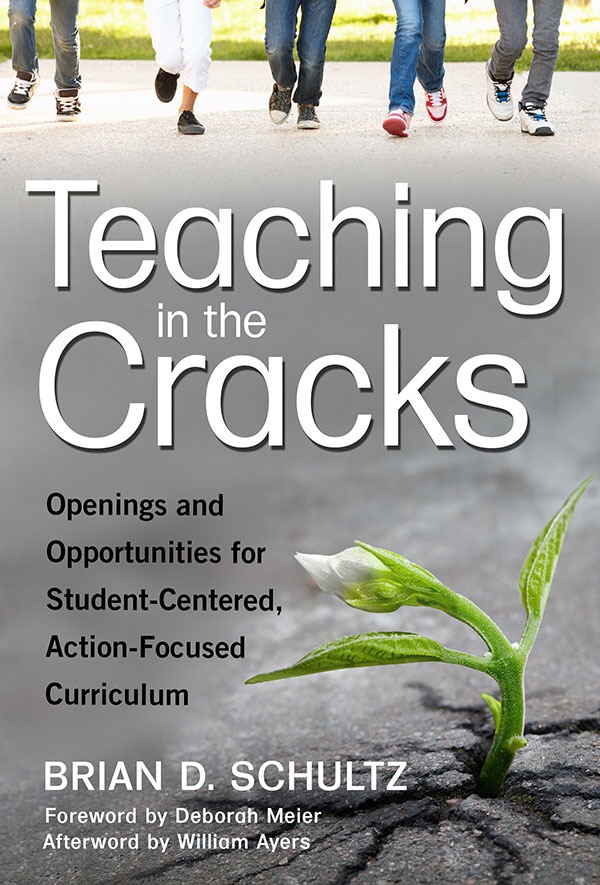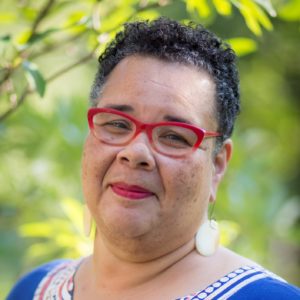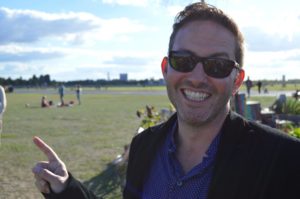justice
Select an item by clicking its checkbox

Teaching in the Cracks
Date Reviewed: September 6, 2018
Brian D. Schultz New York, NY: Teachers College Press, 2017 (xiv + 128 pages, ISBN 9780807758311, $29.95) Teaching in the Cracks by Brian D. Schultz, a professor of education at Northeastern Illinois University in Chicago, explores ways to make current K-12 classrooms more student-empowering, justice-oriented, and action-based. It is not that already available curricula are not student-empowering, have no concern for justice, or ...
Teaching in the Cracks: Openings and Opportunities for Student-Centered, Action-Focused Curriculum
Brian D. Schultz
New York, NY: Teachers College Press, 2017 (xiv + 128 pages, ISBN 9780807758311, $29.95)
Teaching in the Cracks by Brian D. Schultz, a professor of education at Northeastern Illinois University in Chicago, explores ways to make current K-12 classrooms more student-empowering, justice-oriented, and action-based. It is not that already available curricula are not student-empowering, have no concern for justice, or seldom inspire creative student actions; What most concerns the author are school systems that dictate almost everything that students experience, think, and do. In such a system, says Schultz, learning is largely top-down, authoritarian, controlled by agendas that perpetuate the status quo, and “bombarded by standards, assessments, [and] evaluations” (86). Shultz’s critiques and enthusiasm focus on reforming this “troubling” system and more specifically on transforming current everyday curricula in classrooms (86). His proposal, however, stays at the level of reforming or transforming, rather than completely negating or overhauling our current educational practices. That is why he calls his suggestive methodology and transformative tactics “teaching in the cracks.” He encourages educators to find creative loopholes in the present system where they can make education more democratic, collaborative, and thus bottom-up.
Schultz acknowledges that his proposal sounds great on paper but is hard to implement in the classroom, and so throughout he offers numerous practical examples of proposed curricula and how they are working around the nation. Examples vary, covering everything from a single classroom, the entire school’s curriculum, forming close partnerships with surrounding communities, and specific topics, to teacher preparation (all covered in chapters two to six). Together they make this book an invaluable reference for field educators. In particular, chapter six, “Becoming the Teacher I Want to Be: Finding Support to Teach in the Cracks,” and chapter seven: “Turning the Corner: Techniques, Resources, and Tools for Taking-Action,” should be helpful for those who would like to implement the proposed learner-centered class education in a seemingly impotent school context. In chapter six, Schultz gives two fine examples of veteran teachers who introduced several effective strategies that are applicable to other contexts as well. To be sure, contexts differ. Yet, as long as a similar school structure is involved (for example, executive administrators, a sizable student body and its own governing entity, supportive community groups, and an aspiring teacher), these strategies would be beneficial anywhere. Websites introduced in chapter seven are extremely useful resources too.
This book is not per se a theoretical book on student-centered, action-focused curriculum. Rather, it is full of vivid examples of actual current practices. Some readers may find this book insufficiently radical to make a dramatic change in the existing school system, but that is not the author’s purpose. Its particular strength lies in its unabashed focus on the classroom itself. The author believes that the real change can and must happen in each individual classroom where the teacher and students meet for daily education, before any large-scale systematic change is possible. In this respect, this book provides a small, yet reliable, hope for most field educators who, like me, aspire to create a more learner-led class environment.
Alice laughed. “There’s no use trying,” she said: “one can’t believe impossible things.” “I daresay you haven’t had much practice,” said the Queen. “When I was your age, I always did it for half-an-hour a day. Why, sometimes I’ve believed as many as six impossible things ...
If you are like me, the weeks since the inauguration of the 45th president of the United States have been filled with shock, horror, disbelief, sadness and fear. These feelings come not only from the executive orders and policies that have been emerging from the White House but even more ...

Working Side by Side: Creating Alternative Breaks as Catalysts for Global Learning, Student Leadership, and Social Change
Date Reviewed: November 30, -0001
Sumka, Porter, and Piacitelli offer both the history and strategy of an emerging educational model that crosses borders between disciplines to develop competencies and leadership characteristics for social change. The authors document “short-term, student-run immersion service trips” designed to sharpen critical thinking and deepen commitment to future action for social justice (8). In this study their primary example of the alternative break movement is an organization called Break Away that grew out of Vanderbilt University. This and other new programs like the Alternative Break Citizenship school (ABCs) are rooted in efforts from the 1960s that experimented in transformational learning experiences combining travel, intercultural dialogue, collective action, and critical theorizing. A common denominator of these programs is the goal of social justice education.
One theoretical framework undergirding these programs is an “active citizen continuum” pointing the way toward authentic relationships for life-long reflection, action, and community enrichment (10). The integration of critical theory and practice moves participants beyond charity and critical theorizing to active citizenship and intercultural competence. A key component of these programs is student leadership. By practicing the actual implementation of the model from the planning and training stages, students gain confidence and facility with each step of the work. In addition to providing the history and theory behind the programs, this book offers practical details contributing to the success of the learning. Readers find pointers on working relationships between staff and students as organizers and leaders of the trips, the alcohol and drug free policy, clarification of the roles of staff versus student leaders, as well as ideas about training, assessing, and fund-raising.
The study would be strengthened by further development of the concept of justice. Despite the significance of social justice to this work, little attention is given to making explicit what is meant by justice. Similarly, the concept of global learning could be explored in relationship to literature on intercultural dialogue, collective action, and transcending political borders. Although this book provides an introductory discussion of what community means, contrasting communities of affinity versus communities of geography, the extensive body of work in philosophical and critical theory developing that distinction is not acknowledged (351). In other words, the academic and intellectual strands contributing to this model are not noted with as much care as the recent history of the particular program.
This is a compelling read for anyone interested in learning that fosters authentic relationships rooted in “values of social justice, dignity, empowerment, and capacity building” (33). Although religious and theological frameworks are not discussed directly, schools or educators who offer immersion or intercultural learning experiences will benefit from reading this research. The authors’ caution about the tendency to slip toward do-gooder tourism, poverty tourism, and forms of educational travel where privileged students unwittingly perpetuate legacies of colonialism is timely and relevant.The conclusion of this book includes observations about the “need for inspiration and collective action” (359). If faith communities hope to be known as sources of inspiration and collective action in the future, this book offers potential for fertile common ground.

Discerning Critical Hope in Educational Practices
Date Reviewed: August 3, 2016
Discerning Critical Hope is a continuation of the work of Paulo Freire, whose famous Pedagogy of the Oppressed (1970) formed a basis for critical and liberation pedagogy. While his early work included hope, he reiterated the importance of that portion of his framework in Pedagogy of Hope (1992). A small but growing literature on critical hope is extant in the field of pedagogy, but this idea has not yet made many inroads into the published works of theologians, despite its connections with liberation theology and the other contextual and critical branches of theological discourse and activism. (Works on critical hope in the religious education and theology literature include: Bock, “Climatologists, Theologians, and Prophets,” Cross Currents; Kim, “Seeking Critical Hope in a Global Age,” Religious Education; and Kuhne, “A Community Pedagogy of Critical Hope,” PhD dissertation). Many readers of the Wabash Center’s publications will undoubtedly already teach in a way consistent with the critical and liberative themes in Freirean thought, critiquing oppressive social structures and advocating for a world grounded in God’s justice and love. After deconstructing oppressive systems and our complicity in them, however, it can be difficult to provide hope in the theological classroom. I personally find it challenging to move students beyond critique and not simply leave ministry students and seminarians with the task of reconstructing their shattered beliefs and worldviews on their own.
Critical hope provides a way forward. Within this framework, critique and hopefulness cannot be separated: the point is that we need both. We need to be able to critique the world as it is, while retaining hope for a different future. Within this framework, the educator engages history with a critical lens, invokes students’ imaginations, envisioning a different way, and provides space for practical steps to enact that vision.
Discerning Critical Hope includes chapters by a number of scholars, educators, and practitioners. The authors distinguish between critical hope, naïve hope, and false hope. Naïve hope is optimism without a sense of personal responsibility: expecting that things will turn out alright even if one puts forth no effort to make it so. False hope refers to the idea that working hard will result in one joining the oppressing class, a personal rather than systemic release from injustice. Several chapters critique neoliberal education and other forms of supposedly equality-based educational practices that promise merit-based successes, while in reality supporting colonial and patriarchal systems of power. These can serve as cautions for those who teach religion as well. Which of the forms of hope offered in classrooms are naïve or false hopes? Are faculty willing and able to be drawn to a deeper level of hope that can handle the paradox and mystery of critique, of looking in the face of real suffering and injustice, and struggling – hope-filled – toward a better world?
Although each chapter has its helpful points, I found chapters 2, 5, and 10 most useful. Chapter 2, “Teaching for Hope: The Ethics of Shattering Worldviews,” by Megan Boler, provides hope for my own teaching. Boler recognizes the real difficulties in engaging critical hope in the classroom: intentionally invoking a pedagogy of discomfort is, not surprisingly, uncomfortable for students and educators alike. Boler states that, when utilizing this pedagogical method, about a third of students will be receptive, about a third will be vocally and angrily resistant, and another third will be numb or apathetic. She shares a difficult classroom experience, including her fears and other feelings as she navigated dealing with resistant students. It gave me courage to continue practicing this form of teaching.
Chapter 10 provides a brief history of thinkers who have written about hope, from the Greek myth of Prometheus to Francis Bacon, Immanuel Kant, Georg Hegel, Karl Marx, W.E.B. Du Bois, Ernst Bloch, and Paulo Freire. This provides a helpful entry point into different explications of hope throughout history, especially since many of these philosophers had such a major impact on Western culture and on theology. This chapter delineates how and why critical hope differs from previous understandings of hope.
Chapter 5, “Plasticity, Critical Hope and the Regeneration of Human Rights Education,” by André Keet, explains critical hope through the lens of deconstruction, bringing Derrida and other philosophers into the conversation. Keet describes critical hope as that leftover form present after deconstruction occurs, that kernel of truth or “trace” that remains when one strips away all the systems and structures that get layered on top of that essential form. Forms must be physical, must be enacted: these traces cannot remain metaphysical or theoretical, but must be lived.
For theological educators, as we critique and deconstruct, we hope and trust there is an essential kernel there for our students to discover, a trace, a divine encounter or transcendent truth, a knowing that goes beyond the laws and organizational structures with which we so often burden our faith. As we critique, we also hope: we sense something there, something infinite, personal and universal, a never-changing essence and a dynamic Spirit of creative transformation. We can never pin it down; it is always a process of becoming. Hope is a means and an end, a way of being and a goal to strive for, but we cannot know for what we hope without critiquing the present context and imagining a different world. Nor can we truly hope unless we embody that hope in praxis, naming the problem, developing a solution, enacting it, reflecting, modifying, and trying again in a constant cycle of transformation.
Though the authors of this text do not often discuss religion or spirituality, these topics do come up at points, and the struggles to name injustice and enact a truly just and hope-filled form of education will be recognizable to many religious educators. I recommend this book to educators in the religious academy who want to enact a form of education that goes beyond the banking model, who want to challenge their students to engage in critical thinking, who need courage and a sense of solidarity from knowing they are not alone in this struggle, and who also sense a deep undercurrent of hope in taking one step, and then another, toward that imagined future.

